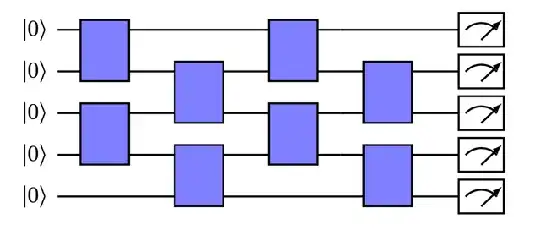I was confused about something related to quantum $1$ designs.
Let us recap two facts we know about random circuit ensembles that form a $1$ design.
- $1$ design, for a quantum circuit over $n$ qubits, means that the density matrix of the ensemble is equal to the maximally mixed state over $n$ qubits.
- If for depth $d$, a random circuit ensemble is a $1$ design, then it is also a $1$ design at depth $d+1$ and beyond.
Now, consider the following random circuit ensemble, taken from Figure 1 (a) here.
As mentioned in the paper, each violet box is drawn independently from the Haar measure on $\mathbb{U}(4)$.
Now, consider a circuit constructed like this, whose depth is exactly $1$. That is, we start with the all zeros state, apply a random gate to each of the $n/2$ pairs of qubits, and then measure in the standard basis.
It is not hard to work out that the ensemble is a $1$ design.
However, I am not sure how to prove that the ensemble remains a $1$ design (or even an approximate $1$ design) when we increase the depth to $2$ and beyond. The calculations for the depth $1$ case do not immediately generalize.
What is going on here?
Note that it is known that such architectures become $2$ designs (and hence, $1$ designs too) after linear depth. However, I am interested in the behaviour in constant or $\log n$ depths.
Additionally, the fact that the depth $1$ case is a $1$ design seemed to rely heavily on the type of gate set chosen. What if we change the gate set to another universal gate set --- like all single qubit gates and the CNOT gate?
Does it still remain a $1$ design (or an approximate $1$ design) or is the gate set in question very special?
